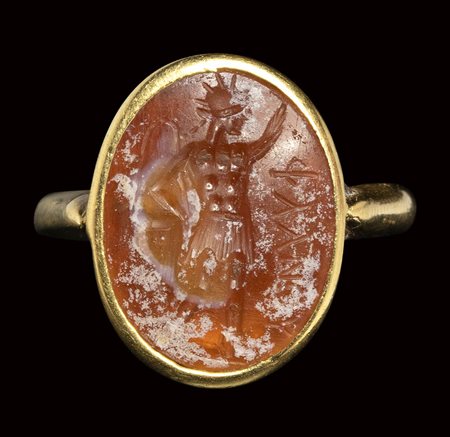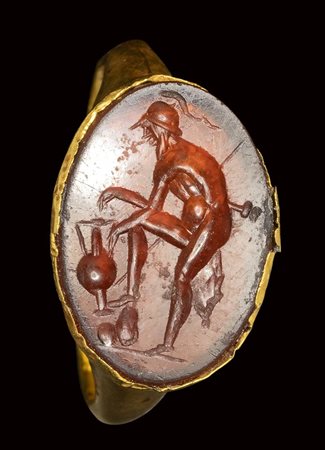ASTA 107 - Glittica
-

Lotto 145 A roman agate intaglio set in a gold stick pin. Apollo.
2nd - 3rd century A.D.
The divinity is facing right. In his right hand he holds a drapery, a laurel branch in his left; on his shoulder, a quiver. The subject is engraved on a three-layered agate (magic eye). Very good condition.
Stone 11 x 15 mm; H. 70 mm; 5.20 gr. -

Lotto 146 A roman burnt carnelian intaglio set in a gold ring. Sol Invictus.
2nd - 3rd century A.D.
The god is standing, with his head radiated and with his right hand raised, in the typical pose of the Sol Invictus; with his left hand he holds the solar whip and a drapery. In the field, a greek inscription. Partially burnt surface of the stone.
Stone 13 x 17 mm; ring size 18 mm; 7,12 gr. -

Lotto 147 A roman carnelian intaglio set in a gold ring. Heraclides attempting a draw.
1st century A.D.
The hero is depicted in profile, with his right foot resting on a rock, as he attempts a draw inside an amphora. The Greek warrior is naked, helmeted and armed with a spear and sword. Groundline. The subject is taken from the group of Three Heraclides who attend the draw with the amphora, a mythical episode with complicated events. Wear marks. Ring formed by a hollow sheet of gold. Rare subject.
Parallel: U. Pannuti, Catalogo della collezione glittica vol I, Napoli, Museo Nazionale, n. 147-148.
Stone 10 x 14 mm; ring size diam 16 mm; 1,83 gr.
-

Lotto 148 A roman carnelian intaglio set in an ancient gold ring. Warrior.
1st - 2nd century A.D.
The figure is depicted in a reclined position, on the ground, and leans on a shield with his left arm, while with his right hand he touches another shield on top of an armor, with a shield. Probably a votive representation or of lamentation towards a comrade who died in a military act. The ring is formed of hollow sheet gold. Wear marks and little missing on the bezel edge.
Stone 9 x 13 mm; ring size 14 mm; 1,18 gr.
-

Lotto 149 A rare roman carnelian intaglio. Scene of a sacrifice by Agamemnon.
1st century BC - 1st century AD.
The Achaeons' supreme leader, wearing a helm, is portrayed holding the shield with his left hand, while offering a patera with his right hand, in front of a small altar at his feet. A bull at his side, and others helmets/ shields on the background, in order to symbolize soldiers. The scene can be identified for sure with the sacrifice that Agamemnon made at Aulis before sailing to Troy. Indeed, this rare iconography can be identified in an ancient sardonic intaglio, the which was also displayed by in the collection of Paoletti’s glass paste impressions, and preserved in Philadelphia (University of Pennsyilvania Museum of Archeology and anthropology, inv. 29-128-900, already M. Sommerville collection).
11,5 x 13 x 5 mm. -

Lotto 150 A roman carnelian fragment of an intaglio. Fighting scene with putti.
2nd century A.D.
In the center, an erote subdues another winged erote to the ground, with a victorious hold for submission; on the left, a referee blows a long trumpet to announce victory. Groundline. Fragmentary stone.
10 x 12 x 3 mm. -

Lotto 151 A rare roman citrine intaglio. Apollo.
2nd century A.D.
This gem has lacks on the edge and chips. However, the young naked figure who appears to be leaning on a tripod (?), could be identified with Apollo. Citrine of extraordinary intense and brilliant color. Rare.
9,5 x 12 x 4 mm. -

Lotto 152 A roman carnelian intaglio. Warrior.
1st - 2nd century A.D.
The soldier advances to the right, with the frontal torso and the head turned back in profile. The figure is naked and protected by a shield and helmet. With his right hand he holds the spear; the sword is hung with a belt. Groundline. Typical pose inspired by Greek models. Fine quality for the small size of the stone. Slight wear marks.
9x12x3 mm -

Lotto 153 An eastern roman green chalcedony intaglio. Military fight scene.
2nd - 3rd century A.D.
A soldier on horseback advances against a soldier on the ground (wearing an helmet and holding a shield). The character on horseback raises a spear to kill his enemy and appears to be characterized by a headdress (Leontea?). Greek inscription on the background. Probably Alexander the Great fighting a soldier. Wear marks. Eastern workshop.
17 x 22 x 4 mm. -

Lotto 154 A large concave roman amethyst intaglio. Silenus.
2nd - 3rd century A.D.
Unusual work, propably from a provincial eastern atelier. A muscular Silenus advances to the left, holding the thyrsus with his left hand and a cup with his right hand. The choice of the amethyst is to be connected to the Dionysiac theme. Large cabochon gem, engraved in the concave inner part. Wear marks.
24 x 34 x 11 mm. -

Lotto 155 A roman red jasper intaglio. Fight scene.
2nd - 3rd century A.D.
Two young characters fight in front of an altar. In the background, on the right, a tree; on the left, a winged erote raising a laurel wreath for the next winner. Groundline. Well composed scene. Attractive color of the stone. Slight wear marks.
15x18x3 mm -

Lotto 156 A roman republican burnt agate intaglio. Biga.
1st century B.C.
Two horses are running to the left, pulling a small chariot driven by a charioteer with a whip. The stone was heated by the fire. Small chips on the edge.
9 x 16 x 2 mm. -

Lotto 157 A roman carnelian intaglio. Faun with goat.
1st century B.C. - 1st century A.D.
The scene shows a bucolic scene with a faun turned left playing with a goat. The mythological character is in flexion, his left leg and arm forward, catching one animal horn, while his other arm holds a branch with a string, in order to excite the goat. Groundline. The anatomical features of both figures and the rendering of volumes with some use of globular elements are well executed. Nice polishing for the engraving, and sign of use on he surface of the stone.
15x17x3 mm -

Lotto 158 A roman red jasper intaglio. Winged eros with rooster.
1st - 2nd century A.D.
The scene shows a winged eros standing left toward a rooster and holding a laurel wreath. Groundline.
7x10x2 mm -

Lotto 159 A roman green chalcedony intaglio. Bucolic scene.
1st- 2nd century A.D.
The scene shows an old male character wearing a large cloak and a stick, seating on a rock in front of a column supporting a vase. Above, branch of fruit. Probably a shepherd in front a votive altar. Groundline.
7x10x2 mm
-

Lotto 160 A roman garnet intaglio. Eros with a torch.
3rd century A.D.
The figure leaning on an overturned torch can be identified both as an erote and as a funerary genius. In fact, the inverted torch symbolizes the sunset of life and the funerary world. Slight wear marks.
11 x 12 x 3 mm. -

Lotto 161 A roman agate intaglio. Fortuna-Tyche.
2nd - 3rd century A.D.
The figure is standing, facing right. With her right hand she holds the cornucopia, with her left the rudder. On the head, a modius. Three-layered agate (magic eye). Slight wear marks with traces of heat.
11 x 14 x 5 mm.
-

Lotto 162 A roman burnt agate intaglio. Mercury.
2nd century A.D.
The deity faces right. With his left hand he holds the purse with coins, with his right the caduceus. The surface of the stone is slightly burnt.
11 x 15 x 6 mm. -

Lotto 163 A roman burnt carnelian intaglio. Victory.
1st century B.C.
The figure is winged, tunicated and depicted frontally. With the right hand she holds a palm branch, with her left a laurel wreath, symbols of victory and triumph. The stone is burnt.
13 x 15 x 2,5 mm. -

Lotto 164 A roman carnelian intaglio. Seated Zeus.
2nd century A.D.
The god is seated, facing right, holding a scepter in his right hand, and a globe in the left one. At his feet, on a column, an eagle. Groundline. Wear marks.
10x14x3 mm -

Lotto 165 A roman amethyst intaglio. Two soldiers.
2nd century B.C.
Slightly convex on the engraved side. A standing soldier with crested helmet is carrying the lima body of a dead fellow. Each wears a cuirass over a short chiton. Groundline. Similar gems with same subject referenced and classified as etruscanizing group III by Richter.
Parallel: for a similar depiction see Richter M.A, Catalogue of engraved gems, 2006, pl.XXXIV, 218
14x16x6 mm -

Lotto 166 A roman rock crystal intaglio. Diogenes in his pithos.
1st century B.C.
The old philosopher is shown facing left, the upper part of his body outside from the pithos and holding a papyrus (?). This iconography is linked to the famoust greek philosopher’s lifestyle, far from social conventions and affluence he was renowned for fleeing comfort, sleeping in a simple pithos. Extraordinary work engraved on a very thin gem with the backside slightly cabochon. Parallel: AGDM (Munchen) n. 2757. AGDS Munchen, vol. 2 n. 1007-1008.
13x15x3 mm -

Lotto 167 A roman two-layered agate intaglio. Harpocrates.
2nd - 3rd century A.D.
The figure is standing, to the right. With his right hand he holds the cornucopia, symbol of abundance; the left hand is raised towards the face, in its typical gestures. The effigy, of magical and protective power, is engraved on a large, slightly cabochon two-layered honey agate on a white background. Slight crack at the bottom left.
15x18x6 mm -

Lotto 168 An eastern roman agate scaraboid engraved seal. The return of Dionysos.
2nd century A.D.
The scene shows Bacchus seated on a chariot pulled by two panthers. Groundline. The god is depicted naked, the lower part of his body covered by a drapery, in his right hand he holds a cup, meanwhile his left hand holds a scepter surmounted by a veil. The style of the depiction suggests that the intaglio is roman, but carved on an more ancient scaraboid seal, probably eastern Greek.
17x21x12 mm
